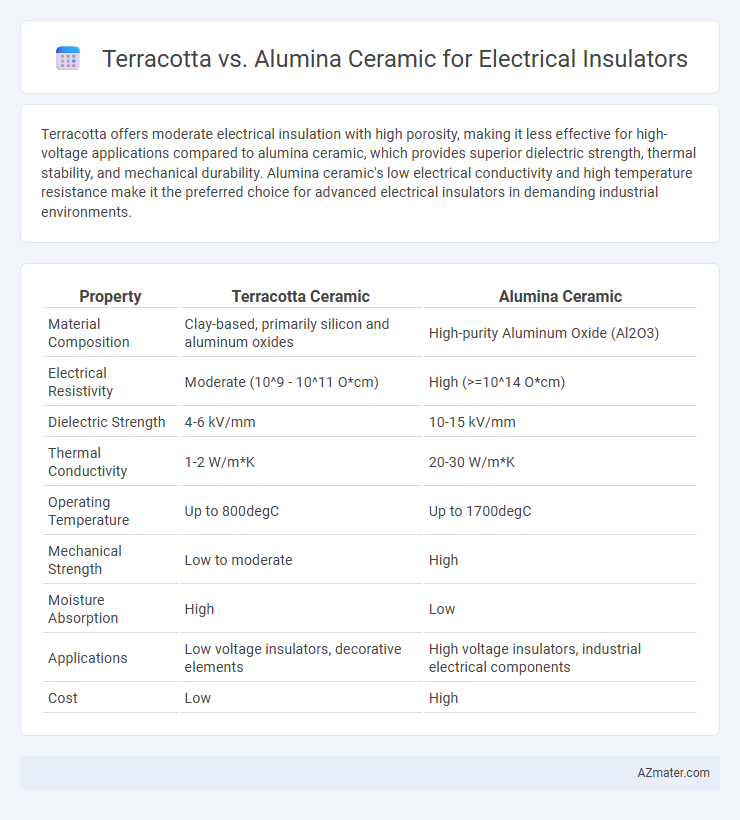Terracotta offers moderate electrical insulation with high porosity, making it less effective for high-voltage applications compared to alumina ceramic, which provides superior dielectric strength, thermal stability, and mechanical durability. Alumina ceramic's low electrical conductivity and high temperature resistance make it the preferred choice for advanced electrical insulators in demanding industrial environments.
Table of Comparison
| Property | Terracotta Ceramic | Alumina Ceramic |
|---|---|---|
| Material Composition | Clay-based, primarily silicon and aluminum oxides | High-purity Aluminum Oxide (Al2O3) |
| Electrical Resistivity | Moderate (10^9 - 10^11 O*cm) | High (>=10^14 O*cm) |
| Dielectric Strength | 4-6 kV/mm | 10-15 kV/mm |
| Thermal Conductivity | 1-2 W/m*K | 20-30 W/m*K |
| Operating Temperature | Up to 800degC | Up to 1700degC |
| Mechanical Strength | Low to moderate | High |
| Moisture Absorption | High | Low |
| Applications | Low voltage insulators, decorative elements | High voltage insulators, industrial electrical components |
| Cost | Low | High |
Introduction: Importance of Insulator Materials in Electrical Applications
Insulator materials like terracotta and alumina ceramic play a critical role in electrical applications by preventing unwanted current flow and ensuring safety and reliability. Terracotta offers natural thermal stability and cost-effectiveness, while alumina ceramic provides superior mechanical strength, high dielectric strength, and excellent resistance to wear and corrosion. Selecting the appropriate insulator material directly impacts the efficiency and longevity of electrical systems in various industrial and commercial settings.
Overview of Terracotta and Alumina Ceramics
Terracotta ceramics are composed mainly of natural clay fired at lower temperatures, offering moderate mechanical strength and excellent thermal insulation properties, making them suitable for low to medium voltage electrical insulators. Alumina ceramics, primarily made from aluminum oxide (Al2O3), exhibit superior hardness, high dielectric strength, and exceptional thermal conductivity, ideal for high-performance electrical insulation applications. The choice between terracotta and alumina ceramics depends on factors such as voltage requirements, thermal conditions, and mechanical durability needs in electrical systems.
Material Composition and Manufacturing Process
Terracotta electrical insulators are primarily composed of natural clay and kaolin, fired at relatively lower temperatures around 1000degC, resulting in a porous but cost-effective material suitable for low voltage applications. Alumina ceramic insulators consist mainly of high-purity aluminum oxide (Al2O3), typically exceeding 99%, and undergo a high-temperature sintering process above 1600degC that produces a dense, highly durable, and electrically insulating structure ideal for high voltage environments. The manufacturing of alumina ceramics requires precise powder processing and controlled atmospheres to achieve superior mechanical strength and enhanced dielectric properties compared to the more traditional, lower-strength terracotta.
Electrical Properties Comparison
Terracotta exhibits moderate dielectric strength and relatively high electrical resistivity, making it suitable for low to medium voltage insulators but limiting its use in high-voltage applications. Alumina ceramic offers superior electrical insulation with dielectric strength often exceeding 10 kV/mm and exceptionally low dielectric loss, providing excellent performance under high-voltage and high-frequency conditions. The higher purity and density of alumina ceramic result in enhanced electrical stability and longer service life compared to terracotta in demanding electrical insulator environments.
Mechanical Strength and Durability
Terracotta exhibits moderate mechanical strength and is prone to cracking under high stress or impact, limiting its durability in demanding electrical insulator applications. Alumina ceramic offers superior mechanical strength with high hardness and excellent resistance to wear, ensuring enhanced durability and stability under thermal and mechanical stresses. The high purity and dense microstructure of alumina make it a preferred choice for long-lasting electrical insulation in rigorous environments.
Thermal Resistance and Performance
Terracotta ceramics offer moderate thermal resistance withstanding temperatures up to approximately 1000degC, making them suitable for general electrical insulation applications with stable performance under normal operating conditions. Alumina ceramics exhibit superior thermal resistance, tolerating temperatures above 1700degC, and maintain excellent electrical insulation properties even in high-temperature and high-stress environments. The enhanced thermal conductivity and mechanical strength of alumina contribute to longer lifespan and greater reliability in demanding electrical insulator applications compared to terracotta.
Cost Analysis: Terracotta vs Alumina Ceramic
Terracotta is significantly more cost-effective than alumina ceramic for electrical insulators, with raw material and production costs typically 40-60% lower. Alumina ceramic offers superior electrical insulation properties and higher mechanical strength, but its manufacturing process requires advanced technology, increasing overall expenses. For budget-sensitive applications, terracotta provides an economical solution, while alumina ceramic is justified in environments demanding high performance and durability despite higher costs.
Common Applications in Electrical Insulation
Terracotta is commonly used in low-voltage electrical insulation applications such as insulator bases for power lines and transformers due to its cost-effectiveness and good dielectric strength. Alumina ceramic excels in high-voltage and high-temperature environments, frequently applied in semiconductor manufacturing, high-power electrical devices, and spark plug insulators because of its superior electrical resistivity and mechanical strength. Both materials offer distinct advantages tailored to specific electrical insulation needs, with terracotta favored for traditional infrastructure and alumina for advanced, demanding applications.
Environmental Impact and Sustainability
Terracotta ceramics exhibit lower environmental impact due to their natural clay composition and energy-efficient, low-temperature firing processes, resulting in reduced carbon emissions compared to alumina ceramics. Alumina ceramics require high-temperature sintering and mining of bauxite, leading to increased energy consumption and resource depletion, which challenges their sustainability profile. The biodegradability and recyclability of terracotta further enhance its environmental sustainability as an electrical insulator material.
Conclusion: Choosing the Right Ceramic Insulator
Terracotta offers cost-effective insulation with moderate mechanical strength, making it suitable for low-voltage and indoor electrical applications. Alumina ceramic provides superior electrical resistivity, high thermal conductivity, and excellent mechanical durability, ideal for high-voltage and harsh environmental conditions. Selecting the right ceramic insulator depends on balancing application voltage, environmental factors, mechanical demands, and budget constraints.

Infographic: Terracotta vs Alumina Ceramic for Electrical Insulator
 azmater.com
azmater.com